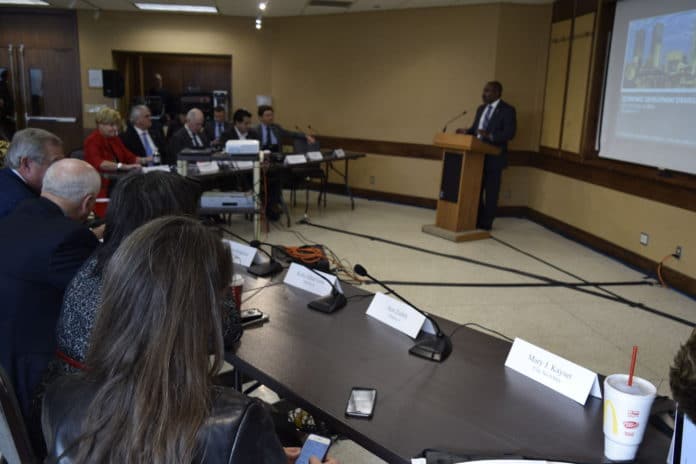Fort Worth officials heard a hopeful – if sobering – assessment of the city’s economic development potential on Dec. 12 as the Fort Worth City Council received a briefing on the city’s first comprehensive economic development plan.
The plan calls for major changes in the way the city and business leaders seek to keep the nation’s fastest-growing large city economically competitive. The plan is designed to give the city the economic tools necessary to compete successfully on the national and international stage for creative, high-growth businesses and to develop and nurture the talent necessary to attract and sustain those businesses.
Goals supporting that vision address competitiveness, creativity and community vitality.
The plan calls for Fort Worth to take a more strategic approach in attracting new businesses, in particular corporate headquarters, but to also work to keep the large businesses that are already here. The plan also puts a focus on entrepreneurs and the creative class, working to keep innovation and innovators in the area.
“The City of Fort Worth has an opportunity – even a responsibility – to capitalize on its growing size, influence and economic potential,” said Robert Sturns, director of the Economic Development Department. “The plan is a road map for the city’s economic development program. Just as important, it is a call to action so that Fort Worth can embrace its status as a major U.S. city and compete on the national and international stage.”
Sturns expects some requests to implement this plan to be part of the fiscal year 2019 budget process, while others may be part of a future bond fund request.
The 500-plus page report also calls for the creation of a Medical District Task Force, a group that will be charged with laying the foundation for new investments and policies to accelerate economic growth in this district.
“A lot of your future growth is going to hinge on what happens not just on downtown, but really the entire area inside the urban core from the Near Southside, Panther Island, Cultural District, Southeast Fort Worth, some of the urban core of Fort Worth,” said John Karras of TIP Strategies of Austin, who was the lead consultant on the project.
According to the materials: “The plan is a road map for the city’s economic development program. Just as important, it is a call to action so that Fort Worth can embrace its status as a major U.S. city and compete on the national and international stage.”
“This is hand down the most comprehensive plan we’ve worked on,” said Karras.
The plan had some “very specific outcomes” according to the executive summary, seeking to build an economic base for the city with high-wage job growth, a more sustainable tax base driven less by residential property valuation and more by commercial and industrial investment, an economy that capitalizes on high-growth businesses and the creative community, and a commitment to “quality of place” throughout the community.
The city paid for the initiative through its general fund with a budget of $350,000. The project is expected to come in slightly under budget. Lead consultant TIP Strategies has offices in Austin and Seattle and worked with partners Fregonese Associates, JLL and Isaac Barchas on the plan.
One of the initiatives outlined in the executive summary looks at the challenge of retaining existing businesses.
Using as an example XTO’s recent announcement that it was transferring most of its employees to the Houston area, the report outlines a plan – with both the city and chamber working together — to establish a business retention program to prevent such economic “surprises.”
There are several surprises in the report, such as the fact that there are 160 Inc. 5000 firms in the Dallas-Fort Worth metro area across a range of industries. Sixty of those are in Dallas and 11 are based in Fort Worth. Plano, Addison and Irving each have more than Fort Worth.
During the discussion on the project, council members touched on some sensitive cultural topics, such as the city becoming known as a suburb of Dallas if Fort Worth is not able to market itself with a separate identity from its eastern neighbor.
The city also has issues with too many Fort Worth residents living here but leaving to work in surrounding municipalities. That is one reason that Fort Worth’s commercial tax base is smaller than its residential tax base, a metric that City Manager David Cooke has often pointed to as an issue the city needs to address.
To remedy that, Karras said, Fort Worth needs to provide more jobs here, particularly high-wage jobs.
The city’s use of the Molly logo also came up for discussion. District 3 Councilman Brian Byrd said the city might consider changing its logo from a longhorn cow. That drew gasps from some councilmembers
The Fort Worth Chamber of Commerce will unveil a four-year strategic plan in early 2018 that, in addition to more proactive and targeted business recruitment, will focus on talent development and attraction, advocacy and small-business support. Staff and resources are being realigned to fortify this structure, and fundraising efforts to support implementation will begin in January.
To accomplish this goal, the chamber has been talking to business leaders in Fort Worth and raising funds to execute the plan, upping its budget from $5 million to $8 million.
“Because of our region’s rapid growth and intense competition, we are defining roles, responsibilities and specific goals for measurable results in a more detailed way than ever before,” said Brandom Gengelbach, the chamber’s executive vice president of economic development. “Economic development is a shared responsibility among local entities and baseline activities need to be expanded so these plans can be fully optimized.”









